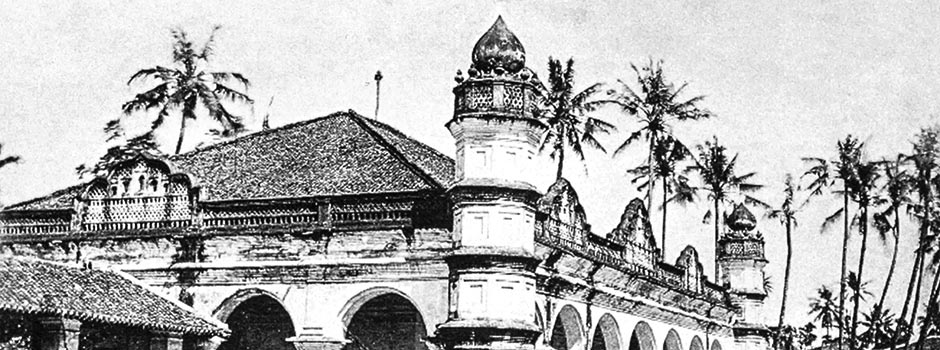
THE ISLAMIC ARTS MUSEUM MALAYSIA (JAN 28 - MARCH 28, 2016) Photo Exhibition ‘The Chulia in Penang’
Feb 09, 2016 Photography

 Early 20th-century photograph showing George Town, now part of the Historic Cities of the Straits of Malacca World Heritage Site. The photograph is taken from the Malayan Railways clock tower on China Street Ghaut / Wade Collection
Early 20th-century photograph showing George Town, now part of the Historic Cities of the Straits of Malacca World Heritage Site. The photograph is taken from the Malayan Railways clock tower on China Street Ghaut / Wade Collection
"In 1989, I started exploring about Penang as a historic port city. Chulia Street, with its Muslim sacred sites and Indian bungalows hidden behind the Chinese shop houses, fascinated me. As much was already known about Nanyang Chinese networks, I was determined to discover Penang's role in the Indian Ocean monsoon trade. The Masjid Kapitan Keling mosque chairman approached me to write a book about the mosque; this was in 1996, the year when my daughter was born. In order to do so I had to learn at least a little bit about two impossibly vast subjects – Islam and India – with all their internal diversity. My daughter was already 17 when I finished the book." - Khoo Salma
 Early 20th-century photograph of Tamil Muslims in Penang / Courtesy of the Penang State Museum
Early 20th-century photograph of Tamil Muslims in Penang / Courtesy of the Penang State Museum
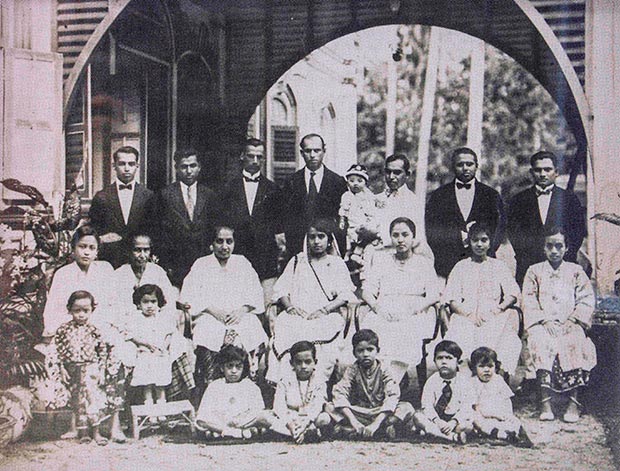 A.O. Merican and his sons formed a prominent branch of the ‘Merican clan’ descended from Cauder Mohuddeen. This photograph shows the family gathered at their home. / Courtesy of Yusoff Azmi Merican
A.O. Merican and his sons formed a prominent branch of the ‘Merican clan’ descended from Cauder Mohuddeen. This photograph shows the family gathered at their home. / Courtesy of Yusoff Azmi Merican
-properties_Courtesy-of-JUPEM-Penang.jpg) The Kelly Map (1893) depicting the Kapitan Keling Mosque and the surrounding endowment (waqaf) properties. The Old Burial Ground and large square masonry tank with stepwell in Kampung Kolam were part of the Cauder Mohuddeen private waqf / Courtesy of Jabatan Ukur dan Pemetaan Pulau Pinang (JUPEM-Penang)
The Kelly Map (1893) depicting the Kapitan Keling Mosque and the surrounding endowment (waqaf) properties. The Old Burial Ground and large square masonry tank with stepwell in Kampung Kolam were part of the Cauder Mohuddeen private waqf / Courtesy of Jabatan Ukur dan Pemetaan Pulau Pinang (JUPEM-Penang)
Penang, a northern state of Peninsular Malaysia, also known as The Island of Pearl, was a part of the British Straits Settlements. It has attracted many migrants from other part of the world such as Chinese, Armenian, Acehnese, European and India which have transformed the state to a cultural melting pot and not forgetting its rich culinary heritage that has become the trademark of this land.
Nasi Kandar and Pasembur, some of the most popular signature dish of Penang, are only a glimpse of the Chulia’s identity, the fore-fathers of the Jawi Peranakan of Penang. The Chulias, originally from the Coromandel Coast of South India, migrated to Penang and prospered as traders of Pelikat cloth, pepper and local products in the Straits of Malacca. In the 19th century, they enriched the port town of Penang with endowment (waqf) for mosques, sufi shrines, burial grounds, a water tank as well as holding religious feasts and processions. Under the mosque endowment, the leader of the Chulia, Kapitan Keling Cauder Mohudden, a Marakkayar shipowner, merchant and progenitor of the Merican Clan founded the Kapitan Keling Mosque in 1801. Since its establishment, the mosque has become the socio-cultural hub for the Muslims in Penang.
 A 19th-century view of Chulia Street, showing the street congested with bullock carts and rickshaws / Wade Collection
A 19th-century view of Chulia Street, showing the street congested with bullock carts and rickshaws / Wade Collection
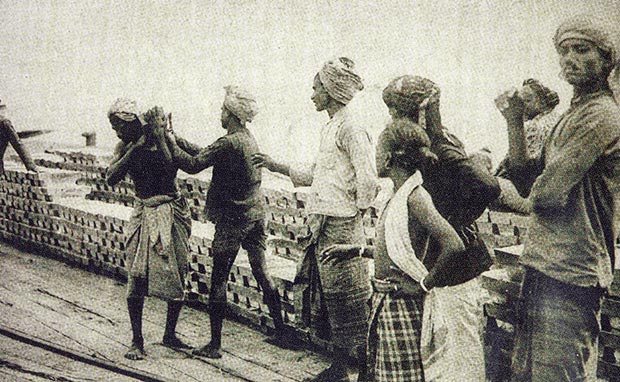 Tamil Muslims conveying heavy tin ingots at the wharf / Wade Collection
Tamil Muslims conveying heavy tin ingots at the wharf / Wade Collection
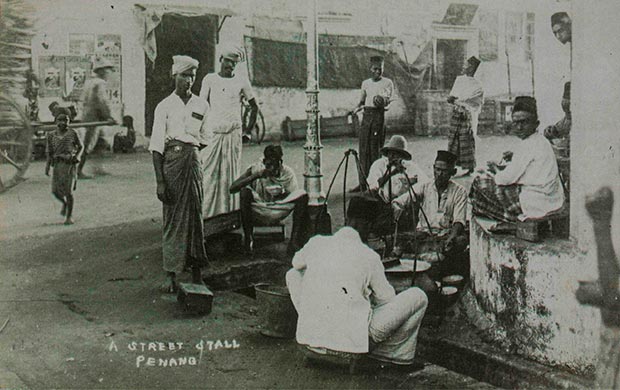 Customers enjoying Mamak food at a street junction, sold by itinerant hawkers carrying their food in baskets suspended from shoulder yokes (kandar) / Wade Collection
Customers enjoying Mamak food at a street junction, sold by itinerant hawkers carrying their food in baskets suspended from shoulder yokes (kandar) / Wade Collection
From the intermarriage between the Chulia and the local Malays, the Jawi Pekan and Jawi Peranakan were born and assimilated with the Malay community. They play an important role in the political and economic as well as cultural and literary progression. Boria and Bangsawan are the two hybrids of cultural forms that entered the mainstream of modern Malay performing arts which are still preserved until today. The earliest Malay newspaper, the Jawi Peranakkan, which was published in Singapore was spear headed by a group of literate Jawi Peranakan.
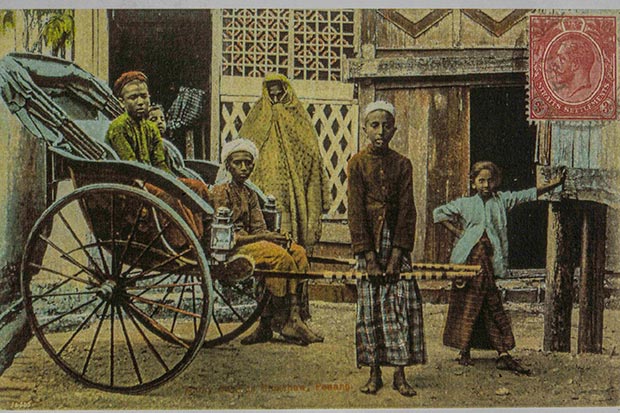 Jawi Pekan children of Tamil background in a rickshaw / Wade Collection
Jawi Pekan children of Tamil background in a rickshaw / Wade Collection
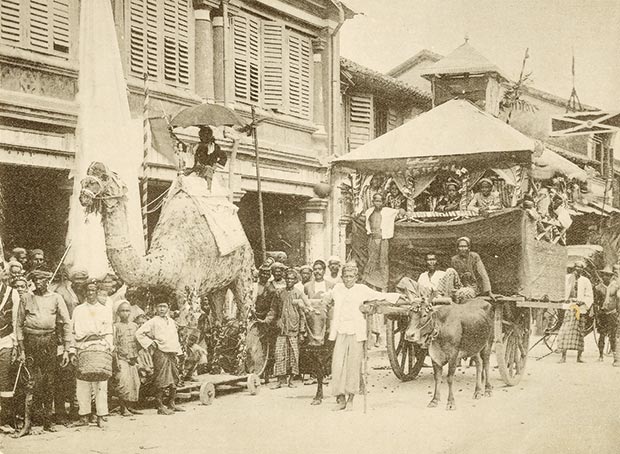 Boria was a spectacle that combined song, dance, and satirical sketches with elements of mimicry, staged by ordinary people representing both religious and profane characters. The photograph shows a Boria contingent with a camel on wheels and a bullock-drawn float during the Queen Victoria Diamond Jubilee, 1897 / Courtesy of National Archives of Malaysia
Boria was a spectacle that combined song, dance, and satirical sketches with elements of mimicry, staged by ordinary people representing both religious and profane characters. The photograph shows a Boria contingent with a camel on wheels and a bullock-drawn float during the Queen Victoria Diamond Jubilee, 1897 / Courtesy of National Archives of Malaysia
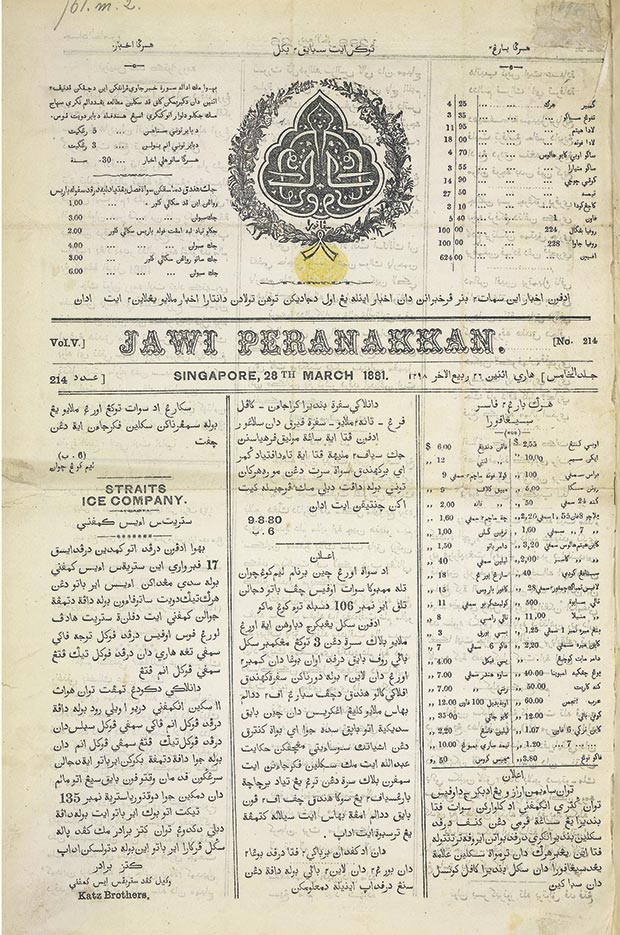 The oldest surviving issue of Jawi Peranakkan / Courtesy of British Library, OP 434
The oldest surviving issue of Jawi Peranakkan / Courtesy of British Library, OP 434
This exhibition highlights the spread of the Chulia diaspora and its contribution to the economic, political, social and cultural development of Penang generally and Malaysia as a whole. A documentary of the Kapitan Keling Mosque directed by Jasmin Abdul Wahab and funded by Finas will also be screened in the exhibition gallery. The music arrangement for this documentary has been contributed by the renowned Academy Award, Grammy Award, Bafta Award, Golden Globe and Oscar Award Winner, A.R. Rahman. This is first time the documentary is being screened in Malaysia.
 Janopakari, a Tamil daily newspaper published in Penang in 1914 by the Mercantile Press, under the editorship of A. Mohamed Abdul Cader / Courtesy of the National Library, Singapore
Janopakari, a Tamil daily newspaper published in Penang in 1914 by the Mercantile Press, under the editorship of A. Mohamed Abdul Cader / Courtesy of the National Library, Singapore
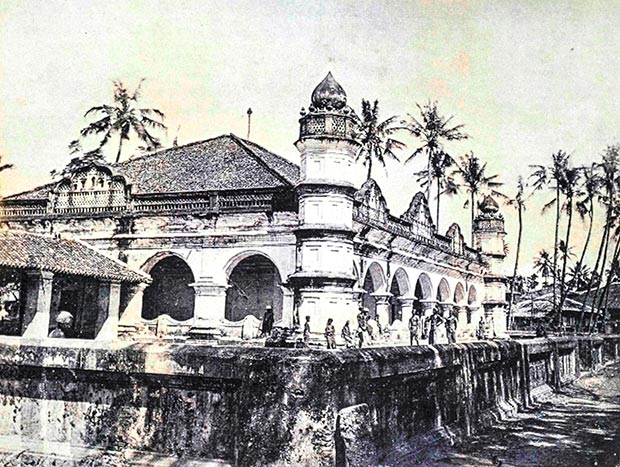 Earliest known photo of the Kapitan Keling Mosque showing a covered walkway to the ablution area next to the wall / Collection of Serge Kakou
Earliest known photo of the Kapitan Keling Mosque showing a covered walkway to the ablution area next to the wall / Collection of Serge Kakou
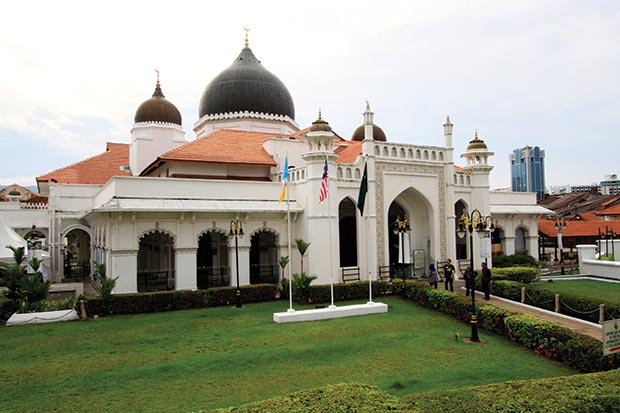 The Kapitan Keling Mosque, Penang / Courtesy of IAMM
The Kapitan Keling Mosque, Penang / Courtesy of IAMM
In conjunction with the exhibition, a special lecture entitled The Chulia in Penang will be held at the Islamic Arts Museum Malaysia on Saturday, 30th January 2016 at 10 am. The author of “The Chulia in Penang: Patronage and Place-Making around the Kapitan Kling Mosque 1786 – 1957â€, Khoo Salma Nasution and the director of the Masjid Kapitan Keling documentary, Jasmin Abdul Wahab will be presenting their stories on the Chulia and the Masjid Kapitan Keling, and the origins of Tamil Muslims. Besides that, the Children’s Library of IAMM will also be organising craft-making workshops every Saturday and Sunday featuring the Chulia cultural heritage such as the craft of Malai Flower that shares its origin from other Indian communities as well as the making of a rickshaw, a signature transportation of the Penang Island.
Comments
Add a comment